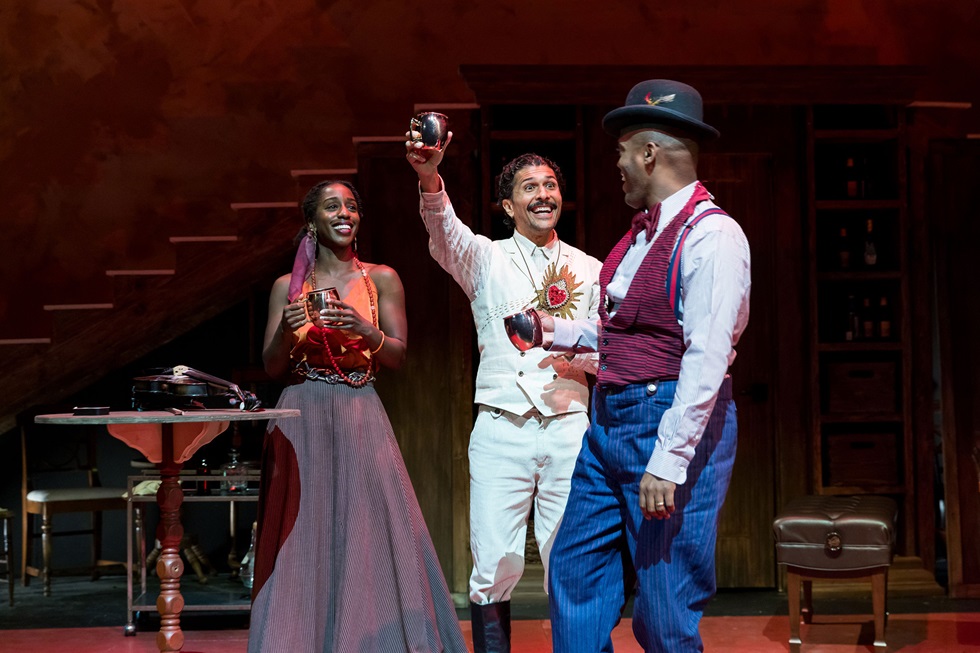
LOS ANGELES — This city’s acclaimed Latino Theater Company opens its Spring 2024 season with the world premiere of Ghost Waltz by prolific playwright Oliver Mayer (Blade to the Heat, Members Only), featuring a cast of eight actor/musicians directed by Alberto Barboza, under the supervision of music director Alberto López. It opened May 4 (seen Cinco de Mayo) and plays through June 2.
Oliver Mayer is a playwright, poet, librettist and professor at USC’s School of Dramatic Arts. He offered his reflections on Juventino Rosas and the play.
“Juventino Rosas’ waltz Sobre las Olas (Over the Waves) is perhaps the most famous song of its generation. Now, more than 130 years after it was written, the tune still feels immediate—sweeping, dreamy, and above all, supremely sure-footed. Every note is both rooted and soaring, coaxing even the wallflowers to dance and sway. It is easily on par with his contemporary Johann Strauss Jr.’s masterwork “The Blue Danube”—to the point that Strauss Jr. is often mistakenly credited with having composed Sobre las Olas.
“Why is this so? Is it simply because Strauss hailed from Vienna, the very center of the waltz craze? Or is there something else, conscious or not, that has kept Juventino Rosas from his rightful place among the great melodists, then and now?
“I wrote Ghost Waltz…to recover the composer’s story. This excavation into Rosas’ life follows a tune that has been haunting me throughout much of my career: Why whitewash so many artists of color? Why bury their names? Why divest the art from the artist? Why erase the rich history of who we are?”

Rosas was a son of the Otomí people, and was born in 1868 in Santa Cruz de Galeana, in the State of Guanajuato, to parents who were Otomí in ethnicity and language. A powerful scene in the first act shows father and son, traveling musicians playing for coins on the streets of Mexico City, and Don Jesús blesses his son in Nahua, with few kind words to say about the blancos who treat the Native peoples so disparagingly. The young Juventino doesn’t understand the language himself, but is nevertheless grateful. That town in the eastern part of the state, incidentally, was renamed Santa Cruz de Juventino Rosas, and a statue of him stands in the central square. The Otomí people continue to thrive there.
There is scant verifiable historical information to be found on Rosas. Son of a guitarist and singer, Juventino took up the violin and was considered a prodigy. An early scene in the play depicts him trying to enter a music conservatory in Mexico City, under the tutelage of an Austrian Jewish Professor Zeiss (who himself has experienced bigotry in his life), but prejudice against Indigenous races prevented him from continuing his studies. After he left formal study, he joined the Mexican Marching Band, which traveled to perform in Chicago in 1893 for the World’s Fair.
In Chicago there also appeared the ambitious young African-American musician Scott Joplin. The playwright surmises they must have met, and reunited in New Orleans, to share musical ideas and thoughts about the nature of their work and the likelihood they’ll never be remembered, and a girlfriend! “A hundred years from now,” Joplin muses, “people will just care what’s between the notes,” not who wrote them or how much money we ever made from them. “Two young men of color, musical virtuosi, at the beginning of their heroes’ journeys,” Mayer postulates, “undaunted by the odds against them, with visions of as-yet-unwritten operas and symphonies dancing in their heads.”
Besides his famous waltz, Rosas composed popular salon music, polkas and mazurkas for the piano. The wife of Mexican president/dictator Porfirio Díaz gifted him a grand piano.
The year after Chicago, Rosas joined an Italian-Mexican musical company that toured Cuba, then still a Spanish colony, but sadly Rosas contracted spinal myelitis and died there at Surgidero de Batabanó on July 9, 1894. He was only 26 years old. In 1909 his remains were transported back to Mexico, which 30 years later later were removed to Mexico City’s Rotunda of Illustrious Men.
Ghost Waltz also imparts a great deal about a world-famous singer of opera and classical song born in the city of Mazatlán named Ángela Peralta, known as the “Mexican Nightingale.” Born over two decades before Rosas, in 1845, she trained in Italy and sang leading roles at La Scala and as far afield as Lisbon, St. Petersburg and Cairo. In his conceit, Mayer makes her a romantic love idol to Rosas, who dreamed she would sing some of his songs. Debuting at the age of 15, Peralta enjoyed a 23-year career, which was cut short when she and her company appeared in Mazatlán in 1883 and most of them, including the diva, caught yellow fever and died. She was 38. In 1937 her remains were also relocated to the Rotunda of Illustrious Men, the first woman buried there. Surely Rosas would have known of Peralta, though their meeting and crossing paths over their short and mostly not contemporary lives, is a conjecture the playwright richly explores.
Tellingly, a frame around the stage bears the Latin expression “Ars longa, vita brevis”—Art endures, life is short.”
Whether historically justified or not, the contrast between the two artists is instructive. Both were Indigenous and brown-skinned. Rosas did not pretend otherwise, but for the sake of her career Peralta used a thick coat of white powder to disguise her complexion and adopted a classist, casteist, Eurocentric posture to separate herself from others she pronounced beneath her. But in the end, both their names and accomplishments eventually became whitewashed and virtually erased. There are, however, a couple of theaters in Mexico, and streets in various cities, bearing her name.
Their experience oddly mirrors another incident, local to Los Angeles, which also involves the playwright Oliver Mayer:
“Many years ago [2010], I wrote the libretto for an opera called America Tropical about the great 1932 mural by David Alfaro Siqueiros on Olvera Street in Los Angeles that was literally whitewashed by the all-white city council and town fathers for its political content. Not only was the image taken forever from us, but the artist was deported, never to return. The center figure of the mural? A 14-foot-tall Indio crucified on a double cross, facing City Hall, foretelling the fate of his violent erasure, the double injustice of past and present bigotry.” That mural has been re-painted in recent years and is now available to be seen.
Commissioned by Latino Theater Company and developed in the company’s Circle of Imaginistas playwriting group, Ghost Waltz is an act of recovery for Juventino Rosas. Mayer’s challenge was, of course, that not a great deal is known about Rosas. One of Mayer’s strategies is to dip into the vivid world of Mexican folklore where duendes, spirits of the dead, continue to exert a living presence. Mayer has three such characters, the still powerful Don Jesús, Juventino’s father and musical inspiration, Professor Zeiss from the conservatory, and Marie Laveau, a renowned voodoo enchantress from New Orleans, where the relationship between Scott Joplin and the Mexican composer deepens. The whiteface used to depict the skeletal spirits à la Day of the Dead is a loud echo of the whiteface performers felt they had to use to pursue their careers. At the same time, as Prof. Zeiss points out, spirits also appear in the European repertoire, such as in the excerpted Erlkönig by Schubert.
So, as in the opera El último sueño de Frida y Diego (The Last Dream of Frida and Diego), spirits play a critical role. No one is truly alone on Earth when the spirits of the dead are readily accessible for advice, wisdom, and perhaps even magical intervention.
Mayer introduces generous portions of music, drama, passion, spirituality and dance to fill out the story where factual information is lacking.
The cast is musically distinguished. Actor, multi-instrumentalist and composer Quetzal Guerrero, best known as QVLN and a classically trained violinist, stars as Juventino Rosas. Pianist extraordinaire and Steinway artist Ric’key Pageot, who has toured with Madonna, Christina Aguilera, Cher and Cirque du Soleil, takes on the role of Scott Joplin. And Latin Grammy nominee rising star soprano Nathalie Peña–Comas plays Ángela Peralta, the “Mexican Nightingale,” and regales us with art songs and Viennese waltzes, as well as arias by Verdi and (ahistorically) Puccini. The fictional characters include Don Jesús, portrayed by actor and composer Eduardo Robledo, known for his work with El Teatro Campesino and the San Francisco Mime Troupe; Professor Zeiss, played by Cástulo Guerra; Joplin’s young companion Bethena (actress, dancer and violinist Ariel Brown); and Creole clairvoyant Marie Laveau (Monte Escalante). Bass player Juan Perez rounds out the cast.

The creative team includes production designers Cameron Jaye Mock and Emily Anne McDonald (set, lights, costumes and projections) and sound designer Nathan Davis. The stage appears, when the audience enters, draped in a huge white sheet, suggesting that the story we are about to witness has been covered over in some dusty attic for decades and only now can we remove the sheet and see what we have been missing. The assistant director is Giovanni Ortega. Production stage manager Yaesol Jeong is assisted by Mikayla Bettner.
My impression of this production was that as a kind of double biographical portrait of Rosas and Peralta, where, at least in the case of Rosas, not so much is really known, the play is somewhat didactic and the dialogue a little stiff. The characters don’t have the time or space to fully emerge in all their flesh and blood. As an example, when Peralta finally deals more honestly with her racial background, we are totally unprepared by any previous questions or doubts. “Whiteness was the only way,” she recalls.
Still the story is an important one, and it is told with great imagination and a wonderful score of waltzes, polkas, classical song, opera and ragtime. Perhaps that’s the simultaneous advantage and the shortfall in the show—what we miss in a cast of not all profession actors, we gain, to our delight, in magnificent musicianship.
With that in mind, by all means, go see it! You’ll have a lovely time, and learn some things you probably never knew before. Well, that was my experience and I expect it will be yours.
Ghost Waltz plays on Thurs., Fri. and Sat. at 8 p.m. and Sun. at 4 p.m. through June 2. The Los Angeles Theatre Center is located at 514 S. Spring St., Los Angeles 90013. Parking is available for $8 with box office validation at Los Angeles Garage Associate Parking structure, 545 S. Main St., between 5th and 6th Streets, just behind the theater. For more information and to purchase tickets, call (213) 489-0994 or go to the company website.
A number of feature interviews and articles will go a long way toward introducing the historical cast of characters and their place in history, as well as the playwright, whether or not you are able to attend a performance:
Click here to read the essay by playwright Oliver Mayer at Zócalo Public Square.
Click here to read “This Waltz Once Attributed to Strauss Is Actually by Indigenous Mexican Composer Juventino Rosas,” where you’ll find a scene from Sobre las Olas, a 1950 biopic starring Pedro Infante as the composer conducting his world-famous song for a crowd of the Mexican elite.
Click here to read about Ángela Peralta, the “Mexican Nightingale” at Mexican News Daily.
Click here to listen to the interview with Oliver Mayer on the Playwright’s Spotlight podcast.
We hope you appreciated this article. At People’s World, we believe news and information should be free and accessible to all, but we need your help. Our journalism is free of corporate influence and paywalls because we are totally reader-supported. Only you, our readers and supporters, make this possible. If you enjoy reading People’s World and the stories we bring you, please support our work by donating or becoming a monthly sustainer today. Thank you!












Comments